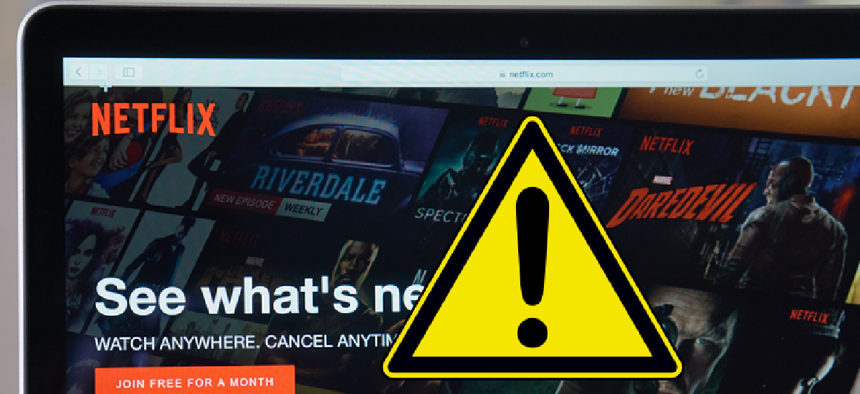Should emergency alerts be issued through Netflix and Pandora?


Connecting state and local government leaders
As Americans increasingly engage with an expanding number of media platforms, many are calling for emergency alerts to be expanded to streaming services or even to internet-of-things-enabled smart home devices.
The percentage of U.S. adults expected to cancel their TV service and continue without it is projected to hit 18.9% this year, with a staggering 39.3 million cutting the cord. But as more consumers rely solely on streaming video and audio services such as Netflix, Hulu, Spotify and Pandora, they may also be inadvertently cutting themselves off from receiving critical alerts broadcast through the emergency alert system.
EAS is run by the Federal Communications Commission, which works with the Federal Emergency Management Agency and National Weather Service to broadcast emergency alerts. The rapid evolution in how Americans consume content presents a challenge for agencies and organizations responsible for ensuring the public safety alerts warn as many residents as possible of impending danger. And it is why many are calling for emergency alerts to be expanded to streaming services platforms, or even to internet-of-things-enabled smart home devices.
What does the system look like today?
While cable and satellite TV and radio stations are required by the FCC to broadcast emergency alerts, there are no similar requirements in place today for streaming services. Last year, Sen. Brian Schatz (D-Hawaii) introduced the Reliable Emergency Alert Distribution Improvement Act, which proposed examining the feasibility of establishing systems and signaling to offer EAS alerts to audio and video streaming services delivered over the internet.
With today’s smartphone ubiquity and the ability to send targeted alerts to a user’s mobile device, some might question the need for expanding broadcast emergency alerts to streaming media services. Yet the fact remains that at home, individuals may not always be close enough to their phones to hear or see that alert, necessitating other approaches to ensure that as many people as possible are notified of impending danger.
To ensure that alerts sent through EAS reach the right people, accurate device and location data is critical. Streaming service providers may not know where the user is watching or listening to streaming media or what device they are using. Users could be watching a Netflix movie on their smartphone in a hotel room, streaming music at Starbucks or using an iPad at the airport.
Additionally, the streaming service providers would need a process for deciding who is sent a given alert. The Integrated Public Alert and Warning System uses FIPS geographical identification codes to determine EAS alerting areas, which is traditionally monitored by local radio and TV broadcasters as well as cable and satellite companies. If Netflix, Hulu and others were to install EAS alerting equipment, they would need a strategic method of monitoring all FIPS codes across the U.S. and then disseminate alerts accordingly.
Another barrier to broadcasting targeted alerts via streaming services may be the virtual private networks consumers often use to securely connect to the internet. While VPNs may give individuals streaming access to TV shows and movies that they would not be able to access locally, their actual IP address is unavailable to the content supplier. With 18% of American internet users employing a VPN in a given month, service providers can never be 100% sure of a user's location, meaning it would be an uphill battle to ensure that people are receiving the appropriate alerts.
What’s next?
Every challenge offers an opportunity. Streaming media services may unlock new possibilities when it comes to alert structure and delivery. After all, the blaring emergency alert might grab people's attention, but it doesn’t necessarily provide the contextual information to help them take appropriate action. Experience in enabling government agencies, public safety departments, law enforcement and businesses to deliver emergency mass notifications shows that alert messaging, timing and consistency are critical to keeping people safe.
When agencies consistently construct their alerts, individuals will learn how to see, hear and read the warnings and understand their significance. For example, using consistent introductions will help people become familiar with the alert messaging format so they can easily recognize different types of alerts. For optimal results, agencies should also regularly test alert delivery and content, including timing and evaluating what information should be provided.
Delivering emergency alerts through streaming media services may offer an opportunity to provide better contextual information than the TV and radio “sirens” and smartphone emergency messages. This information could include weather maps showing the precise location of a hurricane, evacuation routes during a wildfire or street closures for a shelter-in-place scenario.
As policymakers and regulators consider streaming media services as a delivery mechanism for emergency alerts, it is inevitable that some will also look at capabilities of IoT-enabled smart home devices -- whether it’s a digital assistant, smart fridge or internet-connected home security system.
However, hacking is a concern for all emergency alert channels, and these devices may prove particularly vulnerable. Consider the scare a San Francisco family received earlier this year when their hacked Nest camera played a loud alert signal and warned of North Korean missiles directed at Los Angeles, Chicago and Ohio. This cautionary tale should remind agencies not only to deliver emergency alerts in a timely fashion but to ensure these alerts have not been compromised and cause panic. Worse yet, rogue warnings could undermine confidence in the EAS to the point that citizens tune out real alerts.
What were once non-traditional modes of consuming content have become, for the most part, commonplace. This means that evaluating the feasibility of streaming media services for emergency alerts is a healthy conversation to have. The more ways that individuals can be reached before, during and after an emergency, the better -- whether it’s through a streaming service, a “traditional” route or even smart home devices. It’s vital that as many people as possible get timely, pertinent information to make sound decisions in an emergency.




